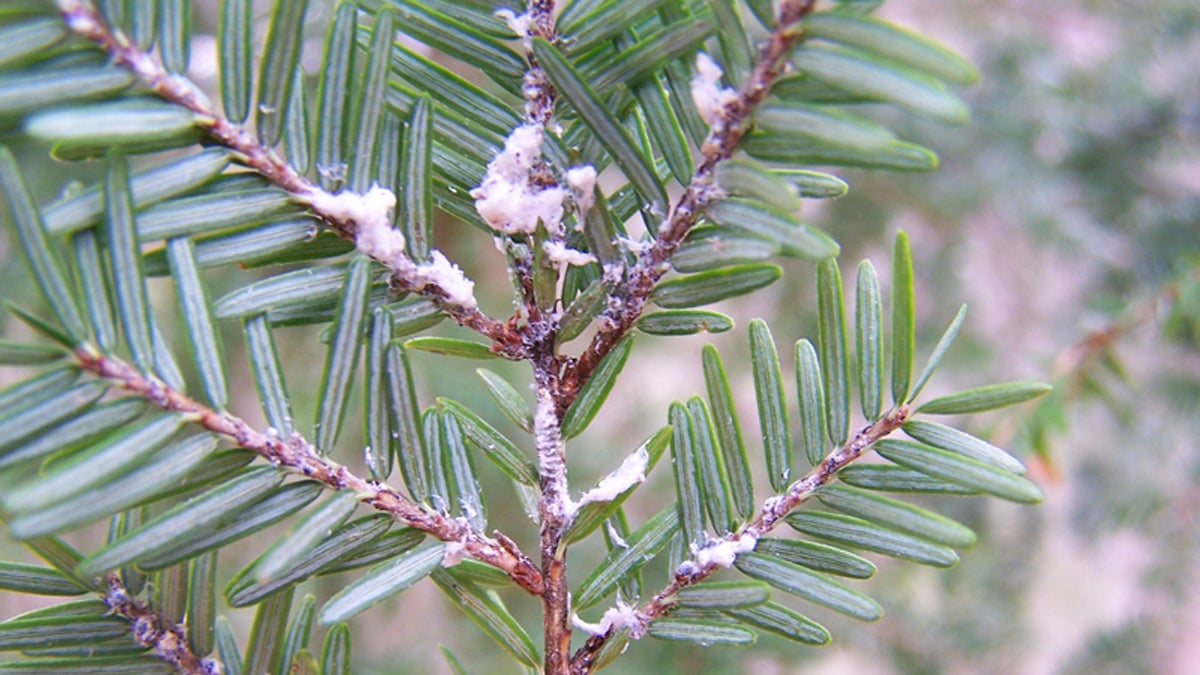What’s eating our evergreen trees?
Listen
(Photo courtesy of the Alliance for Saving Threatened Forests)
Local evergreens have a tiny enemy in the wild, and researchers are enlisting citizen scientists to battle the bugs.
The balsam fir, a tree now starring in many homes as the centerpiece of Christmas decorations, has a tiny enemy in the wild. So does the hemlock, the Pennsylvania state tree.
Their nemesis is a little sucker, literally: an insect called the woolly adelgid.
“It has a piercing, sucking mouthpart almost like a straw, and it puts that straw into the tree’s bark and sucks out the juices,” explains Jason Lubar, Associate Director of Urban Forestry at the University of Pennsylvania’s Morris Arboretum.
You can do something to help these evergreens survive. A group of scientists called the Alliance for Saving Threatened Forests is enlisting volunteer tree spotters. The goal is to identify hemlocks and balsam firs that are healthy, even though surrounding trees are succumbing to the woolly adelgids.
“We’re hoping we can find some natural resistance within our native population,” notes Fred Hain, a forest entomologist with the Alliance. “We’re interested in breeding trees that have resistance to exotic forest pests. So we’re looking for trees that are still alive, look relatively healthy, they may be infested or they may not be infested. But as long as they look fairly healthy, with good crown color, and a fairly dense crown, that suggests to us that they may in fact be resistant.”
So that’s the job for citizen scientists willing to tromp through the woods: spot a healthy tree, record its location, and register it on the project website. More on how to do that in a bit.
In this area, volunteer tree spotters will be focusing on the hemlock, which is native to the region and grows plentifully. Around here balsam firs, especially that Christmas tree favorite, the Fraser fir, grow mostly on Christmas tree farms, where the woolly adelgid tends not to do much damage.
Jay Bustard, of Bustard’s Christmas Trees in Lansdale, is relieved. “We haven’t run into the woolly adelgids much at all. We’ve been very very fortunate.”
Arborist Jason Lubar attributes it to the shorter lifecycle of a farmed Christmas tree. “Typically, the balsam woolly adelgid likes older trees, not younger trees.”
But, back to those hemlocks, which are in trouble and need some help. So, say you’re out hunting hemlocks for the project. You can recognize them by their short, flat needles and scaly brown bark. Their oval cones are small, only about an inch long. Jason Lubar offers some tips on where to spot hemlocks in our area, such as Fairmount Park.
“The Wissahickon is a great place to go, especially in the wintertime,” he advises. “Because the hemlocks are an evergreen, they’ll stand out readily from the other, deciduous trees, meaning trees that lose their leaves in the autumn. Basically, an evergreen will either be a white pine or a hemlock.“
Hemlocks along the Wissahickon Creek have been pretty hard hit by woolly adelgids, Lubar said. He added that you might see hemlocks closer to home too. They’re a favorite of the landscaping industry, so if look around your neighborhood, you can find them there, too.
When you see some hemlocks, take a closer look at their branches. “If you turn over the leaves of a hemlock–with hemlocks they look like needles, but they’re very small leaves,” instructs Lubar. “And the woolly adelgid typically looks like a woolly mass—hence its name—on the underside of the leaf. You’ll probably need glasses or a magnifying lens to really take a good look at these insects.”
If you find a hemlock standing strong amid others that the insects have attacked, mark down the location and approximate height and diameter of the healthy tree. Then, Fred Hain says, go to the website threatenedforests.com to enter the data.
“There’s a Google map there,” he directs. “And you can pinpoint exactly where you are, and hit submit, and it’ll come directly to us. Then we’ll either go there ourselves or contact somebody in the area that’ll go and examine the tree for us.”
The Alliance for Saving Threatened Forests has some preliminary findings on what might enable some trees to survive over others. It has to do with that particular spot where the needle meets the tree branch. That’s where the adelgid pierces the bark to suck out the tree’s juices.
Fred Hain elaborates, “The very first layer of tissue… is thinner in that region than on any other part of the needle, and it happens to be thinnest on Eastern Hemlock, the most susceptible species.” He notes that they still need a lot more specimens to continue their research.
SciStarter is a content partner of WHYY’s The Pulse. You can get more information on this and other citizen science opportunities on SciStarter’s website.
WHYY is your source for fact-based, in-depth journalism and information. As a nonprofit organization, we rely on financial support from readers like you. Please give today.



